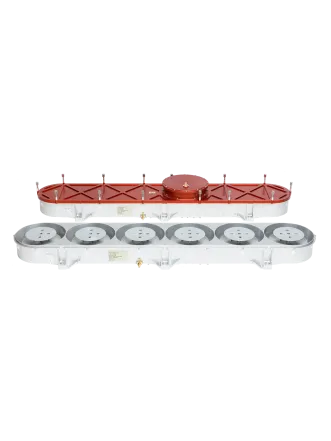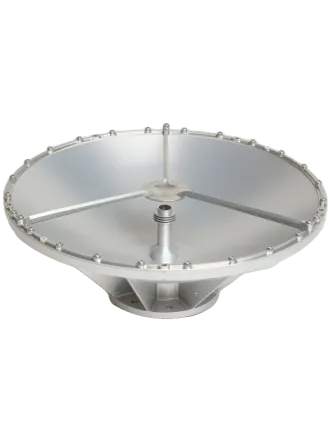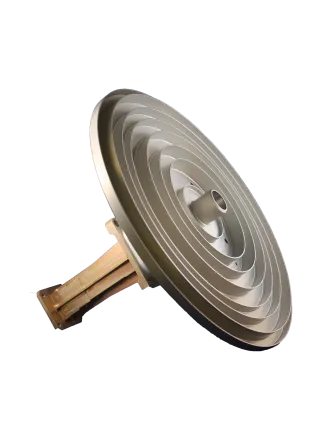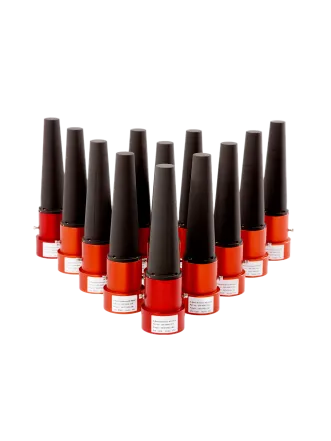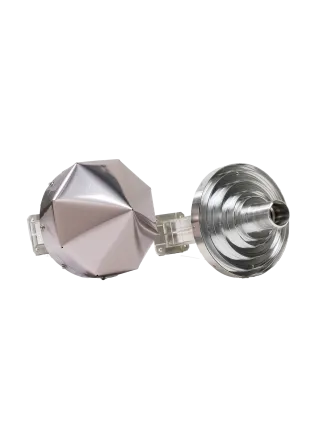
Antennas
High-Quality Antennas for Telecom, TTC, DDL, ISL, and GNSS Receive/Transmit with a 50+ Year Track Record of Success. Our antennas are designed for superior performance, providing reliable and robust solutions for various communication needs.
Beyond Gravity has been a trusted provider of high-quality antennas for over 50 years. Our antennas are used in a wide range of applications, including Telecom, Telemetry and Command (TT&C), Data Downlink (DDL), Inter Satellite Links (ISL), and GNSS Receive/Transmit. With a track record of over 5300 successful antenna deliveries and zero mission failures, we take pride in delivering reliable and high-quality antenna solutions. Our focus is on market areas such as earth observation, navigation, science & exploration, and telecom, but we are always open to new challenges.
Advanced Antenna Technologies for a Diverse Range of Space Applications
At Beyond Gravity, we specialize in advanced antenna technologies and offer a diverse range of products including helix antennas, patch excited cup antennas, reflector antennas, horn & pipe antennas, slotted waveguide antennas, and array antennas. Our innovative designs span across various frequency bands - from L-band to S-band, C-band, X-band, Ku-band, and Ka-band. We perform GTD analysis or satellite mockup measurements and have the expertise to design and supply accessories such as test caps, booms and mounts. Furthermore, we are proficient in the development and manufacture of all required components such as filters, diplexers, OMTs, polarizers, waveguides and cables.
High-Performance, Cost-Effective Antennas with Zero Failures in Orbit
In addition to our diverse range of advanced antenna technologies, Beyond Gravity offers cost-effective solutions with low loss. We provide our customers with high-performance Commercial Off-The-Shelf (COTS) as well as custom-made antennas at competitive delivery times and prices. Our products are designed with the understanding that nothing is a substitute for vacuum, and we strive to provide antennas with high power handling capability and good radiation pattern performance. Our commitment to quality and reliability is reflected in our track record of 0 failures in orbit.
Extended GNSS PEC Antenna for Precise Orbit Determination (POD)
The Extended PEC Antenna is an ideal choice for precise orbit determination (POD) applications where antenna phase center stability is essential. It offers improved performance with reduced spacecraft illumination, lowered cross-polarization, and reduced omni variation. Operating across all GNSS bands, from L5/E5a, E5b, L2 to L1/E1, it provides near hemispherical coverage.
The antenna features a compact design with a diameter of 200 mm, a maximum height of 87 mm, and a mass of 735 g. It has a female SMA connector as RF interface, which can face either sideways or directly into the spacecraft.
Compact GNSS PEC Antenna for Small Spacecraft with High Vibration Tolerance
Our compact GNSS PEC antenna is designed for smaller spacecraft where the quadrifilar helix antenna and the extended PEC antenna may be too high. It operates at all GNSS bands, from L5/E5a, E5b, L2 to L1/E1, and offers highly stable RF performance. The antenna has a diameter of 160 mm, a maximum height of 55 mm, and a mass of 325 g. It has a female SMA connector as RF interface and is designed to cope with very demanding vibration loads, as normally used or boom mounted TT&C antennas.
High-Gain GNSS PEC Antenna for GEO Satellites
Our high-gain GNSS PEC antenna is designed for geostationary orbit (GEO) satellites. It operates at the GNSS L1/E1 band (also capable of Glonass G1 use) and offers increased boresight gain. The antenna has a diameter of 239 mm, a maximum height of 179 mm, and a mass of 715 g. It has a female SMA connector as RF interface.
Low-Mass, Single-Frequency GNSS PEC Antenna
For missions and applications requiring a single-frequency antenna with low mass and volume, this GNSS PEC antenna is an excellent choice. It operates at the GNSS L1/E1 band and is also capable of Glonass G1 use. The antenna has a diameter of 144 mm, a maximum height of 35 mm, and a mass of 220 g. It has a female SMA connector as RF interface, and the SMA interface faces directly into the spacecraft.
Compact GNSS Quadrifilar Helix Antenna with Low Back Radiation
Our compact GNSS quadrifilar helix antenna is designed to minimize satellite disturbances with its extremely low back radiation. This is achieved through a special feeding technique that reduces back radiation by 5-10 dB. The antenna design is patent protected.
The antenna operates at GNSS frequencies from 1.176 GHz (L5/ E5a), 1.227GHz (L2) to 1.575 GHz (L1/E1) and has hemispherical coverage. It features a diameter of 90 mm, a maximum height of 410 mm, and a mass of 815 g. It has a female TNC connector as RF interface.
Test Caps/Hats for GNSS Antennas
Test caps/hats are available for all our GNSS antennas. For all antennas except the L1 PEC antenna, the caps/hats are absorptive with a set coupling value (e.g., 10, 15, 20 dB, etc.). The L1 PEC antenna test cap/hat is of a 0 dB coupling type.
GNSS/GPS Navigation Transmit Antennas
Our wideband, PIM-free, high-power GNSS/GPS Navigation Transmit Antennas are designed to meet the needs of upcoming generations of L-band navigation signal transmit antennas. Leveraging our heritage in L-band mobile communication antennas for space, we have developed array elements and arrays that are compliant with the latest GPS and Galileo signal definitions.

Satellite Based Augmentation System (SBAS) Transmit Antennas
Our SBAS Transmit Antennas play a crucial role in enhancing the accuracy, integrity, and availability of space-based navigation systems. These wide band, PIM free antennas with high power capability are based on our heritage in L-band mobile communication and navigation antennas for space. They are compliant with EGNOS and WAAS signal definitions.
Array Elements for L- and S-Band Mobile Communication Satellite Systems
Beyond Gravity has developed high-performance array elements for L- and S-band mobile communication satellite systems. The array elements offer excellent performance in terms of low mass, high aperture efficiency, low losses, and superior high-power handling and PIM performance. The element design is cost-efficient and suitable for large-scale production. Beyond Gravity Space has a significant heritage in array element design and manufacturing, having delivered nearly 4000 elements over the years.
Feed Array Elements for Ku Band with Integrated Filter Functions
Our cutting-edge Feed Array Elements are currently under development, designed for either focal plane or direct radiating at the side. The product features a Ku band sub-array quadruplet of dual-polarized feeds with integrated filter functions, offering superior performance and efficiency.
Multi-Beam Antennas for LEO Constellation Systems
Our User/Mission Multi-Beam Antennas enable multiple beam coverage in LEO constellation systems, supporting L-band, S-band, and C-band frequencies. We offer both simultaneous and switchable beam footprints, giving you the flexibility to meet your specific mission needs.
Our featured C-band medium gain multi-beam antenna array provides a seven-beam footprint on Earth from LEO, while our compact global coverage C-band array antenna is ideal for applications requiring global coverage.
Waveguide Array Technology for C-band SAR Antennas
Waveguide array technology is at the forefront of C-band synthetic aperture radar (SAR) antennas, which have been essential for weather forecasts since the groundbreaking ERS-1 ESA mission. Our synthesis and design methods, coupled with innovative concepts for slotted waveguide arrays, enable us to design and build arrays with exceptional performance in terms of beam shape and side-lobe control. Currently, our technology is being used for the scatterometer instrument on the upcoming MetOp-SG B-satellites.
Radio Occultation Array Technology for GNSS/GPS
Radio occultation (RO) is a rapidly expanding field that is revolutionizing weather forecasting and climate change monitoring. Our Radio Occultation Array Technology is a key player in this field, providing high-performance antennas for missions such as MetOp GRAS and the upcoming MetOp-SG GRAS-2.
The GRAS-2 instrument features two standalone GNSS antennas and one GNSS antenna array, offering flexibility and performance. These antennas can operate independently or in combination with other RO instruments, providing versatility in data collection. They are fully compatible with major navigation satellite systems, including GPS, Galileo, BeiDou, QZSS, and GLONASS.
The array delivers an Earth limb coverage beam with minimal and well-defined group delay variation, ensuring precise measurements. This makes it ideal for a variety of RO applications, including atmospheric temperature and humidity profiling, wind speed and direction retrieval, and ionospheric monitoring.
0.2m Diameter K-Band All-Metal Reflector Antenna (MetOp-SG)
Beyond Gravity Space has developed and space-qualified a small (0.22m diameter K-band all-metal reflector antenna) for the MetOp-SG program. The antenna is suitable for mounting on an antenna pointing mechanism (APM) for mechanically steerable data downlink systems, but can also be used for fixed mounting.
The all-metal concept of this antenna is based on a reflector dish with an integrated feed horn, a sub-reflector integrated tripod, and a polarizer. It is designed for high power transmission at K-band (25.5 - 27 GHz). To prevent Passive Intermodulation (PIM), the antenna features a high-pressure flange between the septum polarizer and the reflector. The standard antenna is circularly polarized (RHCP or LHCP), with the unused port of the septum polarizer terminated. The design can easily be changed to dual polarization operation by adjusting the septum polarizer design only.
The antenna features a frequency range of 25.5 - 27.0 GHz, a boresight gain of 32.6 dBi (25.5 GHz) - 33.3 dBi (27 GHz), and an edge-of-coverage gain of 32.3 dBi (25.5 GHz) – 33.0 dBi (27.0 GHz) at ±0.5°. It also has a cross polarization discrimination of > 29 dB within ±1.0° and a return loss of > 25 dB. The antenna’s RF interface is WR-42 (WR-34 optionally) and it has a power handling capability of 30 W.
0.4m Diameter K-Band All-Metal Reflector Antenna (US Government program)
Beyond Gravity has developed and space-qualified a 0.4m diameter K-band all-metal reflector antenna for a US Government program. The antenna is suitable for mounting on an antenna pointing mechanism (APM) for mechanically steerable data downlink systems, but can also be used for fixed mounting.
The antenna features a frequency range of 25.5 - 27.0 GHz, a boresight gain of 37.2 dBi (25.5 GHz) - 37.7 dBi (27 GHz), and an edge-of-coverage gain of 36.4 dBi (25.5 GHz) – 36.8 dBi (27.0 GHz) at ±0.5°. It also has a cross polarization discrimination of > 22 dB within ±1.0° and a return loss of > 25 dB. The antenna’s RF interface is WR-34 (WR-42 optionally) and it has a power handling capability of 40 W.
The antenna has an overall height of < 140 mm, a diameter of < 400 mm, and a mass of < 1.35 kg. Its mechanical interface is 9 x M5 screws, 2x dowel pins, and its first eigenfrequency is > 300 Hz. The antenna can operate in a thermal environment of –140°C to +150°C.
0.4m Diameter K-Band All-Metal Reflector Antenna (EU Galileo 2nd generation)
Beyond Gravity is developing a 0.4m diameter K-band all-metal reflector antenna for the ongoing EU Galileo second generation mission. The antenna is suitable for mounting on an antenna pointing mechanism (APM) for mechanically steerable data downlink systems, but can also be used for fixed mounting.
The antenna features a frequency range of 22.5 - 23.5 GHz, a boresight gain of 35.1 dBi (22.5 GHz) - 35.5 dBi (23.5 GHz), and an edge-of-coverage gain of 35.0 dBi (22.5 GHz) – 35.4 dBi (23.5 GHz) at ±0.25°. It also has a cross polarization discrimination of > 25 dB within ±0.5° and a return loss of > 25 dB. The antenna’s RF interface is WR-34 (WR-42 optionally) and it has a power handling capability of > 40 W.
The antenna has an overall height of < 120 mm, a diameter of < 350 mm, and a mass of < 1 kg. Its mechanical interface is 12 x M5 screws, 2x dowel pins, and its first eigenfrequency is > 400 Hz. The antenna can operate in a thermal environment of –150°C to +150°C.
0.6m Diameter K-Band All-Metal Reflector Antenna (ESA science mission)
Beyond Gravity has developed and space-qualified a 0.6m diameter K-band all-metal reflector antenna for an ongoing ESA science mission. The antenna is suitable for mounting on an antenna pointing mechanism (APM) for mechanically steerable data downlink systems, but can also be used for fixed mounting.
The antenna features a frequency range of 25.5 - 27.0 GHz, a boresight gain of 41.0 dBi (25.5 GHz) – 41.3 dBi (27 GHz), and an edge-of-coverage gain of 39.4 dBi (25.5 GHz) – 39.6 dBi (27.0 GHz) at ±0.5°. It also has a cross polarization discrimination of > 22 dB within ±0.75° and a return loss of > 25 dB (25.5GHz – 26.5 GHz) and > 20 dB (26.5 GHz – 27 GHz). The antenna’s RF interface is WR-42 (WR-34 optionally) and it has a power handling capability of > 60 W.
The antenna has an overall height of < 160 mm (148 mm w/o SLI), a diameter of < 575 mm, and a mass of < 1.75 kg. Its mechanical interface is 12 x M5 screws, 2x dowel pins, and its first eigenfrequency is > 300 Hz. The antenna can operate in a thermal environment of –150°C to +150°C.
Test Hats for K-Band Link Antennas
High-power test hats for K-band link antennas are essential tools for ensuring accurate and reliable test results in both ambient and thermal vacuum environments. They provide a well-defined RF test environment while ensuring low leakage to maintain electromagnetic compatibility (EMC) and occupational safety.
Test hats for K-band link antennas are available in a variety of sizes and configurations to accommodate a wide range of antennas. They can also be custom-designed to meet specific customer requiremen
X-band Helix Data Downlink Antennas Generation 2 (G2)
The X-band helix data downlink antennas generation 2 (G2) are compact and lightweight, yet deliver higher EOC gain than G1 antennas. Their multifilar helix radiator is fed from a one-piece septum polarizer, allowing for either a waveguide (WR112) or a coaxial (SMA) RF interface. They operate in both 7.8 GHz and 8.0 - 8.4 GHz bands. With EOC variants of 55°, 60°, and 70°, a diameter of 90 mm, and a height of less than 255 mm, they are highly versatile. Plus, they can handle up to 80 W with a waveguide RF interface.
X-band Helix Data Downlink Antennas Generation 1 (G1)
The X-band helix data downlink antennas generation 1 (G1) are compact and lightweight, making them ideal for many LEO missions. Their quadrifilar helix radiator is fed from a conventional septum polarizer, which is made in three main parts. This design allows for either a waveguide (WR112) or a coaxial (SMA) RF interface. They operate in both 7.8 GHz and 8.0 - 8.4 GHz bands. With EOC variants of 60° and 70°, a diameter of 90 mm, and a height of less than 250 mm, they are highly versatile. Plus, they can handle up to 35 W with a waveguide RF interface.
X-band Waveguide Pipe Data Downlink Antenna
Introducing the X-Band waveguide pipe data downlink antenna, a compact yet powerful antenna solution. The radiator of this antenna is a waveguide opening with corrugations, designed to shape the antenna radiation pattern. It’s fed from a conventional septum polarizer, made in one piece, allowing for either a waveguide (WR112) or a coaxial (SMA) RF interface. Designed specifically for the 8.0 - 8.4 GHz band, it boasts very low gain variation vs frequency, ensuring consistent performance.
In terms of technical specifications, the antenna has an EOC of 60°, a diameter of 285 mm, and a total height of less than 235 mm. The height over the mounting I/F is less than 100 mm, and it weighs less than 1000 g. One of its standout features is its high power capability - it can handle up to 240 W with a waveguide RF interface.
Auxiliary Items
Test caps/hats are available for all X-band data downlink antennas. The Helix antenna caps/hats are designed to be absorptive with a set coupling value (e.g., 10, 15, 20 dB, etc.). This feature allows for more precise control and adjustment of the antenna’s performance. On the other hand, the waveguide pipe antenna test cap/hat is of a 0 dB coupling type, making it suitable for high power applications.
Furthermore, a 3 dB S-Band hybrid with an X-band filter function is also available. This can be used in a co-located S-band TTC system and offers more than 25 dB suppression at X-band data downlink frequencies. This feature ensures that the system maintains high-quality transmission and reception by minimizing interference.
Ka-Band 0.2 GHz Bandwidth TTC Antennas
Our Ka-band TTC Antennas, with a bandwidth of 0.2 GHz, are designed for optimal performance and compactness. The TM/TX Antenna, with a diameter less than 80mm and height under 65mm, weighs less than 130g. The TC/RX Antenna is even more compact, with a diameter under 60mm, height less than 45mm, and a weight under 50g. Both antennas offer an EOC greater than 90° and can operate with either single RHCP or LHCP polarization. The TM/TX Antenna operates in the 17.7 GHz to 20.2 GHz band, while the TC/RX Antenna operates in the 27.5 GHz to 30.0 GHz band. Both antennas can interface with either waveguide or coaxial connections and can withstand random vibrations of up to 46.7 g RMS. They have a wide operational temperature range of ± 150°C.
Ka-Band 1.2 GHz Bandwidth TTC Antennas
Our Ka-band TTC Antennas, with a bandwidth of 1.2 GHz, are designed for optimal performance and compactness. The TM/TX Antenna, with a diameter less than 55mm and height under 90mm, weighs less than 95g. The TC/RX Antenna is even more compact, with a diameter under 40mm, height less than 60mm, and a weight under 40g. Both antennas offer an EOC greater than 90° and can operate with either single RHCP or LHCP polarization. The TM/TX Antenna operates in the 17.7 GHz to 20.2 GHz band, while the TC/RX Antenna operates in the 27.5 GHz to 30.0 GHz band. Both antennas can interface with either waveguide or coaxial connections and can withstand random vibrations of up to 46.7 g RMS. They have a wide operational temperature range of ± 150°C.
Ka-Band Full 3 GHz Bandwidth TTC antennas
Our Ka-band TTC Antennas, with a full bandwidth of 3 GHz, are designed for optimal performance and compactness. The TM/TX Antenna, with a diameter less than 55mm and height under 65mm, weighs less than 100g. The TC/RX Antenna is even more compact, with a diameter under 40mm, height less than 45mm, and a weight under 120g. Both antennas offer an EOC greater than 75° and can operate with either single or double RHCP and/or LHCP polarization. The TM/TX Antenna operates in the 17.3 GHz to 20.2 GHz band, while the TC/RX Antenna operates in the 27.0 GHz to 30.0 GHz band. Both antennas can interface with either waveguide or coaxial connections and can withstand random vibrations of up to 46.7 g RMS. They have a wide operational temperature range of ± 150°C.
Auxiliary Items for Ku-Band TTC Antennas
For our Ku-band TTC antennas, we offer test caps/hats as auxiliary items. These test caps/hats are available in two types: absorptive and non-absorptive. The absorptive test caps/hats come with a set coupling value, such as 10, 15, 20 dB, etc. On the other hand, the non-absorptive test caps/hats come with a 0 dB coupling. These auxiliary items enhance the versatility and adaptability of our Ku-band TTC antennas.
High-Performance Ku-Band TTC Antennas with 0.75 GHz Bandwidth
Our Ku-band TTC antennas with 0.75 GHz bandwidth are designed to provide reliable and efficient satellite telemetry and command communication. With their compact size, low mass, and wide operational temperature range, they are ideal for a variety of space applications.
Technical data:
- EOC > 75°
- Diameter < 125 mm
- Height < 125 mm (TM/TX) < 110 mm (TC/RX)
- Mass < 250 g (TM/TX) < 210 g (TC/RX)
- Polarization - single or dual RHCP and/or LHCP
- Frequency band TM/TX 10.70 GHz to 12.75 GHz or TC/RX 13.25 GHz to 14.80 GHz
- Bandwidth - 0.75 GHz within above bands
- RF I/F - waveguide or coaxial possible
- Random vibration 46.7 g RMS
- Wide operational temperature range ± 150°C
Ku-band full 2.0 GHz bandwidth TTC antennas
Our Ku-band full 2.0 GHz bandwidth TTC antennas are the ideal solution for satellite telemetry and command communication that requires high performance and maximum flexibility. With their compact size, low mass, and wide operational temperature range, they are well-suited for a variety of space applications, including scientific satellites, telecommunication satellites, Earth observation satellites, and small satellites.
Technical Data
- EOC > 75°
- Diameter < 90 mm (TM/TX) < 75 mm (TC/RX)
- Height < 75 mm (TM/TX) < 65 mm (TC/RX)
- Mass < 120 g
- Polarization - single RHCP or LHCP
- Frequency band TM/TX 10.70 GHz to 12.75 GHz or TC/RX 12.75 GHZ to 14.80 GHz
- Bandwidth - full 2 GHz band
- RF I/F - waveguide or coaxial possible
- Random vibration 46.7 g RMS
- Wide operational temperature range ± 150°C
Auxiliary Items for Ku-Band TTC Antennas
Test caps/hats are available for all Ku-band TTC antennas. These test caps/hats are absorptive with a set coupling value (e.g., 10, 15, 20 dB, etc.) or non-absorptive with a 0 dB coupling. Test caps/hats are essential for antenna testing and validation, and they help protect the antenna from the environment.
S-Band Helix Antennas for Satellite Telemetry and Command, Generation 3 (G3)
Our S-band helix antennas have been used on numerous scientific and telecommunication satellites since their introduction in the late 1970s. These antennas are known for their excellent performance, low mass, rugged design, and wide frequency band. With over two hundred helix antennas delivered, this antenna type has served numerous scientific and telecommunication satellites in their crucial telemetry and command communication.
Technical Specifications
- EOC (Elevation Over Cut-Off): > 85° to > 115°
- Diameter: 65 mm
- Total Height: < 289 mm
- Height over Mounting I/F: < 204 mm
- Mass: < 235 g
- Frequency Band: 2000 MHz to 2300 MHz
- Random Vibration: 46.7 g RMS
- RF I/F: SMA or TNC available
Patch Excited Cup (PEC) Antennas
The Patch Excited Cup (PEC) antenna is typically used as a fill-in antenna in combination with the helix antenna. Its low profile makes it ideal for use where available accommodation and volume are restricted.
Technical Specifications
- EOC (Elevation Over Cut-Off): 60°
- Diameter: 140 mm (incl. SMA 147 mm)
- Total Height: < 69 mm
- Mass: < 280 g
- Frequency Band: 2000 MHz to 2300 MHz
- Random Vibration: X,Y: 17,2 g RMS; Z: 30,8 g RMS
- RF I/F: SMA
Auxiliary Items for S-Band TTC Antennas
Explore our range of auxiliary items designed to enhance the performance and versatility of your S-band TTC antennas.
Our test caps/hats are a valuable addition to any S-band TTC antenna setup. These absorptive accessories come with a set coupling value (options include 10, 15, 20 dB, etc.), providing you with the flexibility to fine-tune your system for optimal performance.
For those operating a co-located X-Band downlink and S-Band TTC system, our 3 dB S-Band hybrid with X-band filter function is an indispensable tool. Offering more than 25 dB suppression at X-band data downlink frequencies, this hybrid ensures clear and interference-free communication.
X-Band Helix Antennas
Our X-Band Helix Antennas are designed for superior performance and broad coverage. With an EOC 90°, they provide hemispherical coverage, ensuring comprehensive and reliable connectivity. The antennas operate in two frequency bands:
- The broadband TM/TX/DDL frequency band ranges from 7190 MHz to 7250 MHz (RX/TC) and 8025 MHz to 8400 MHz (TM/TX/DDL).
- The narrowband TM/TX frequency band spans from 7190 MHz to 7250 MHz (RX/TC) and 8400 MHz to 8500 MHz (TX/TM).
We offer two variants of the X-Band Helix Antennas:
- The Coaxial I/F variant (SMA) has a diameter of 140 mm, a total height of less than 150 mm, and a mass of less than 325 g.
- The Waveguide I/F variant (WR112) has a diameter of 90 mm, a total height of less than 260 mm, and a mass of less than 415 g.
X-Band Waveguide Pipe TTC Antenna
Introducing our X-Band Waveguide Pipe TTC Antenna, a state-of-the-art communication device designed for optimal performance. With an EOC 90°, it provides hemispherical coverage, ensuring broad and reliable connectivity. The antenna operates in the frequency band of 7145 MHz to 7250 MHz (RX/TC) and 8400 MHz to 8500 MHz (TX/TM), offering robust transmission and reception capabilities. The waveguide I/F variant (WR112) further enhances its efficiency. Despite its advanced features, the antenna maintains a compact form with a diameter of 130 mm and a total height of less than 215 mm. It is also lightweight, with a mass of less than 300 g, facilitating easy handling and installation.
X-Band Medium Gain Waveguide Pipe TTC Antenna
The X-Band Medium Gain Waveguide Pipe TTC Antenna, with its EOC 20°, operates in the frequency band of 7145 MHz to 7250 MHz (RX/TC) and 8400 MHz to 8500 MHz (TX/TM), ensuring high-quality transmission and reception. The coaxial I/F variant (SMA) further enhances its performance. Despite these advanced features, the product maintains a compact form with a diameter of 100 mm and a total height of less than 220 mm. Moreover, it is lightweight, with a mass of less than 410 g.
Auxiliary Items for X-Band TTC Antennas
We offer a range of auxiliary items to enhance the performance of your X-band TTC antennas. Our test caps/hats are available in various configurations, including absorptive models with set coupling values (such as 10, 15, 20 dB, etc.) or with 0 dB coupling, depending on your power handling needs.
In addition, we provide a 3 dB S-Band hybrid with an X-band filter function, which is particularly useful in a co-located X-Band downlink and S-Band TTC system. This hybrid offers more than 25 dB suppression at X-band data downlink frequencies, ensuring efficient and interference-free operation.




